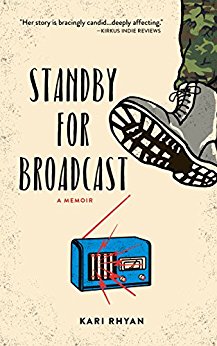STANDBY FOR BROADCAST follows author and narrator Kari Rhyan, a Navy nurse, as she checks herself into a mental hospital with severe PTSD. There, she must recognize and confront the abuse she suffered as a child and the horrors she witnessed while working as a nurse in Afghanistan.
The beginning of STANDBY FOR BROADCAST is shocking and disorienting: the reader is thrown into the story before Kari’s breakdown, right before she goes to the Willows to battle her PTSD. Almost no explanation as to place and circumstance is given, and Rhyan’s writing style—which reads like hectic prose-poetry—leaves the reader with very little sense of what’s happening. Though it’s a jarring way to start the book, it puts the reader in Kari’s head, so we come close to experiencing the same overwhelming feelings she does.
Rhyan’s writing style is conversational, but rhythmic. It breaks out into bouts of caps-lock and ranting that may leave reader’s on their toes, but once used to this style it’s easy to follow. There are a lot of characters to keep track of, but the main ones—Rhyan’s mother, the Skipper; the Raptor; the Spouse; the Kid; Riza; and her fellow patients and army nurses—stick in your mind so vividly that you can’t help but remember them.
The story jumps between Rhyan’s recovery at the Willows, her service at Bastion—the gory British camp in Afghanistan that caused the bulk of her PTSD—and her abusive childhood. Flashbacks come in the form of journal entries, because part of Kari’s recovery program is to write an autobiography. At any moment she, and the story, could be interrupted by a nosy nurse or a patient who wants her attention, which only heightens the suspense.
Rhyan presents herself in a way that’s sympathetic but not perfect. We see her as a child being stomped on by her mother, her mother’s boyfriends, her aunt, and her older cousin, then we see her as a nurse turning off her emotions while she tries to keep a triple amputee alive. When she lashes out at the Willows, we as readers want her to get better, want to see her succeed and overcome. But like most fully formed people, Rhyan also admits to the wrong she’s done: ignoring her child, antagonizing people on Facebook, and depending on substances. All of these traits are fair criticisms that could harm the reader’s perception of her, but through the story we get to see Rhyan criticize her own behaviors and try to work through them. By painting a whole picture of herself, Rhyan doesn’t demand sympathy from her readers, but earns it.
STANDBY FOR BROADCAST is a vivid and often painful memoir that demonstrates the necessity of confronting trauma in order to overcome it.
~Jess Costello for IndieReader

